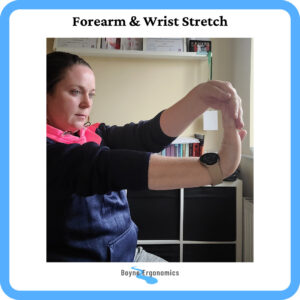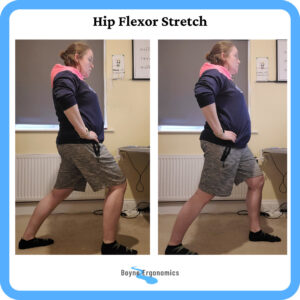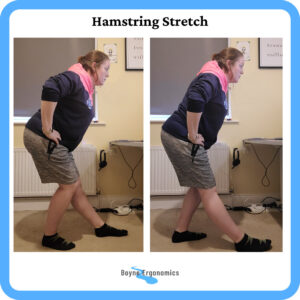In today’s digital age, many of us spend hours hunched over computers, typing away on keyboards, and navigating through endless screens. While this technology-driven work environment has its advantages, it also poses significant challenges to our physical health. One of these challenges is decreased mobility. Prolonged periods of static desk based work can increase the occurrence of muscle tightness and stiffness, reducing our range of functional mobility and impacting our balance. If left unaddressed, this will increase the risk of musculoskeletal injury, even while carrying out simple day to day “low-risk” tasks.
One simple yet effective way to combat these challenges is through regular stretching. In this blog post, I explore the benefits of stretching for computer-based workers and provide examples of gentle stretches to help alleviate common discomforts.
The Benefits of Stretching
Reduces Muscle Tension and Stress:
Prolonged sitting and repetitive movements can lead to muscle tension and stress, particularly in the neck, shoulders, and back. Stretching helps to relieve this tension, promoting relaxation and reducing the risk of muscle imbalances.
Improves Posture:
Poor posture is a common issue among those who spend long hours at a computer. Stretching can help counteract the effects of slouching and forward head posture, encouraging a more upright and aligned stance.
Increases Flexibility and Range of Motion:
Regular stretching increases flexibility and range of motion in the joints. This can lead to better movement efficiency and reduce the likelihood of injuries.
Enhances Circulation:
Stretching stimulates blood flow, which can help deliver essential nutrients and oxygen to muscles and tissues. This improved circulation can reduce the risk of developing conditions like deep vein thrombosis (DVT).
Boosts Mental Clarity and Focus:
Taking breaks to stretch not only benefits the body but also the mind. Stretching can be a quick mental reset, helping to clear the mind and improve focus and productivity.
Gentle Stretches for Computer-Based Workers
When it comes to stretching, keep it simple! It is likely that most of you reading this know these stretches, have probably done them in school, in exercise classes or in the gym. The aim is to gently stretch the main muscle groups that can experience increased stiffness and tension while working at the computer.
Remember to continue to breathe normally while carrying out these stretches, do not hold your breath! Only stretch to the point of slight discomfort, not pain. You will notice that the range of movement in the stretch will increase the more you put these into practice.
Below are examples of simple stretches that can be done at the desk, or better still, during movement breaks from the desk. If possible, I advise moving from the before carrying out these stretches to get the most from them.
Neck Stretch:
Sit or stand up straight. Gently tilt your head towards your right shoulder, trying to bring your ear close to your shoulder. Hold for 15-20 seconds, then switch to the left side. For a deeper stretch, gently place your hand on the side of your head and apply slight pressure.

Shoulder Shrugs:
While sitting or standing, lift your shoulders towards your ears as high as you can, then roll them back and down. Repeat 10 times to relieve shoulder tension.

Forearm, Wrist & Finger Stretch:
Extend one arm in front of you with the palm facing up. Use the other hand to gently pull the fingers back towards you, feeling the stretch in the wrist and forearm. Hold for 15-20 seconds and repeat on the other side. You can also make a fist and then spread your fingers wide to stretch the hands.

Chest Opener:
Stand or sit with your feet shoulder-width apart. Clasp your hands behind your back and gently pull your arms straight, lifting your chest and squeezing your shoulder blades together. Hold for 15-20 seconds.
Upper Back Stretch:
Stand or sit with your feet shoulder-width apart. Interlock your fingers, straighten your arms out in front of you and push your hands away from your body. Hold for 15-20 seconds.

Seated Spinal Twist:
Sit up straight in your chair. Place your right hand on the back of the chair and your left hand on your right thigh. Gently twist your torso to the right, looking over your shoulder. Hold for 15-20 seconds and switch sides.

Hip Flexor Stretch:
Stand up and take a step back with your right leg, keeping your left leg bent at a 90-degree angle. Gently push your hips forward, feeling the stretch in your right hip flexor. Hold for 15-20 seconds and switch sides.

Hamstring Stretch:
Stand with your feet hip-width apart. Extend your right leg forward, keeping the heel on the ground and toes pointing up. Bend your left knee slightly and lean forward from the hips, keeping your back straight. Hold for 15-20 seconds and switch legs.

Conclusion
Incorporating these simple stretches into your daily routine can make a significant difference in your physical well-being, especially if you spend long hours working at a computer. Not only do these stretches help alleviate discomfort and prevent injuries, but they also promote a healthier posture and a more focused mind. So, take a few minutes every hour to stand up, stretch, and give your body the care it deserves. Your body and mind will thank you!
Remember, consistency is key. The more regularly you stretch, the more benefits you’ll experience. Happy stretching!


